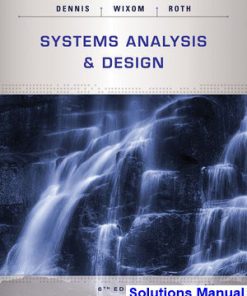Essentials of Systems Analysis and Design 6th Edition Valacich Test Bank
$26.50$50.00 (-47%)
Essentials of Systems Analysis and Design 6th Edition Valacich Test Bank.
You may also like
Essentials of Systems Analysis and Design 6th Edition Valacich Test Bank

Product details:
- ISBN-10 : 0133546233
- ISBN-13 : 978-0133546231
- Author: Joseph S. Valacich
A clear presentation of information, organized around the systems development life cycle mode
This briefer version of the authors’ highly successful Modern System Analysis and Design is a clear presentation of information, organized around the systems development life cycle model. Designed for courses needing a streamlined approach to the material due to course duration, lab assignments, or special projects, it emphasizes current changes in systems analysis and design, and shows the concepts in action through illustrative fictional cases.
Table contents:
PART I FOUNDATIONS FOR SYSTEMS DEVELOPMENT 2
Chapter 1 The Systems Development Environment 2
What Is Information Systems Analysis and Design? 4
Systems Analysis and Design: Core Concepts 4
Systems 6
Definition of a System and Its Parts 6
Important System Concepts 7
A Modern Approach to Systems Analysis and Design 10
Your Role in Systems Development 11
Developing Information Systems and the Systems Development Life Cycle 12
Phase 1: Systems Planning and Selection 14
Phase 2: Systems Analysis 14
Phase 3: Systems Design 15
Phase 4: Systems Implementation and Operation 15
Alternative Approaches to Development 18
Prototyping 18
Computer-Aided Software Engineering (CASE) Tools 18
Joint Application Design 19
Rapid Application Development 19
Participatory Design 21
Agile Methodologies 21
Key Points Review 21
Key Terms Checkpoint 22
Review Questions 23
Problems and Exercises 23
Discussion Questions 24
Case Problems 24
Chapter 2 The Sources of Software 26
Introduction 27
Systems Acquisition 27
Outsourcing 28
Sources of Software 29
Choosing Off-the-Shelf Software 33
Reuse 36
Key Points Review 39
Key Terms Checkpoint 39
Review Questions 40
Problems and Exercises 40
Field Exercises 40
Case: Petrie’s Electronics 40
Chapter 3 Managing the Information Systems Project 42
Pine Valley Furniture Company Background 44
Managing the Information Systems Project 45
Initiating the Project 49
Planning the Project 53
Executing the Project 60
Closing Down the Project 63
Representing and Scheduling Project Plans 64
Representing Project Plans 66
Calculating Expected Time Durations Using PERT 67
Constructing a Gantt Chart and Network Diagram at Pine Valley Furniture 68
Using Project Management Software 71
Establishing a Project Starting Date 72
Entering Tasks and Assigning Task Relationships 72
Selecting a Scheduling Method to Review Project Reports 73
Key Points Review 74
Key Terms Checkpoint 75
Review Questions 76
Problems and Exercises 76
Discussion Questions 78
Case Problems 79
Case: Petrie’s Electronics 80
PART II SYSTEMS PLANNING AND SELECTION 82
Chapter 4 Systems Planning and Selection 82
Identifying and Selecting Projects 84
The Process of Identifying and Selecting Information Systems Development Projects 84
Deliverables and Outcomes 87
Initiating and Planning Systems Development Projects 88
The Process of Initiating and Planning Systems Development Projects 88
Deliverables and Outcomes 89
Assessing Project Feasibility 90
Assessing Economic Feasibility 92
Assessing Other Feasibility Concerns 98
Building the Baseline Project Plan 99
Reviewing the Baseline Project Plan 105
Pine Valley Furniture WebStore: Systems Planning and Selection 108
Internet Basics 108
Pine Valley Furniture WebStore 110
Key Points Review 113
Key Terms Checkpoint 114
Review Questions 116
Problems and Exercises 116
Discussion Questions 117
Case Problems 117
Case: Petrie’s Electronics 119
PART III SYSTEMS ANALYSIS 122
Chapter 5 Determining System Requirements 122
Performing Requirements Determination 124
The Process of Determining Requirements 124
Deliverables and Outcomes 125
Requirements Structuring 126
Traditional Methods for Determining Requirements 126
Interviewing and Listening 126
Directly Observing Users 131
Analyzing Procedures and Other Documents 132
Modern Methods for Determining System Requirements 135
Joint Application Design 136
Using Prototyping during Requirements Determination 139
Radical Methods for Determining System Requirements 140
Identifying Processes to Reengineer 141
Disruptive Technologies 142
Pine Valley Furniture WebStore: Determining System Requirements 143
System Layout and Navigation Characteristics 143
WebStore and Site Management System Capabilities 144
Customer and Inventory Information 145
System Prototype Evolution 145
Key Points Review 146
Key Terms Checkpoint 147
Review Questions 148
Problems and Exercises 148
Discussion Questions 148
Case Problems 149
Case: Petrie’s Electronics 150
Chapter 6 Structuring System Requirements: Process Modeling 152
Process Modeling 154
Modeling a System’s Process 154
Deliverables and Outcomes 154
Data-Flow Diagramming Mechanics 155
Definitions and Symbols 156
Developing DFDs: An Example 158
Data-Flow Diagramming Rules 161
Decomposition of DFDs 162
Balancing DFDs 164
Using Data-Flow Diagramming in the Analysis Process 166
Guidelines for Drawing DFDs 166
Using DFDs as Analysis Tools 168
Using DFDs in Business Process Reengineering 169
Logic Modeling 171
Modeling Logic with Decision Tables 172
Pine Valley Furniture WebStore: Process Modeling 175
Process Modeling for Pine Valley Furniture’s WebStore 175
Key Points Review 177
Key Terms Checkpoint 178
Review Questions 179
Problems and Exercises 179
Discussion Questions 183
Case Problems 184
Case: Petrie’s Electronics 185
Chapter 7 Structuring System Requirements: Conceptual Data Modeling 188
Conceptual Data Modeling 190
The Process of Conceptual Data Modeling 191
Deliverables and Outcomes 191
Gathering Information for Conceptual Data Modeling 195
Introduction to Entity-Relationship Modeling 197
Entities 197
Attributes 199
Candidate Keys and Identifiers 199
Multivalued Attributes 200
Relationships 201
Conceptual Data Modeling and the E-R Model 201
Degree of a Relationship 202
Cardinalities in Relationships 203
An Example of Conceptual Data Modeling at Hoosier Burger 206
PVF WebStore: Conceptual Data Modeling 209
Conceptual Data Modeling for Pine Valley Furniture’s WebStore 209
Selecting the Best Alternative Design Strategy 213
The Process of Selecting the Best Alternative Design Strategy 213
Generating Alternative Design Strategies 214
Developing Design Strategies for Hoosier Burger’s New Inventory Control System 216
Selecting the Most Likely Alternative 218
Key Points Review 220
Key Terms Checkpoint 221
Review Questions 222
Problems and Exercises 222
Discussion Questions 225
Case Problems 225
Case: Petrie’s Electronics 229
PART IV SYSTEMS DESIGN 232
Chapter 8 Designing the Human Interface 232
Designing Forms and Reports 234
The Process of Designing Forms and Reports 234
Deliverables and Outcomes 236
Formatting Forms and Reports 238
Designing Interfaces and Dialogues 246
The Process of Designing Interfaces and Dialogues 246
Deliverables and Outcomes 247
Designing Interfaces 247
Designing Dialogues 258
Pine Valley Furniture WebStore: Designing the Human Interface 262
General Guidelines for Designing Web Interfaces 262
General Guidelines for Web Layouts 262
Designing the Human Interface at Pine Valley Furniture 263
Menu-Driven Navigation with Cookie Crumbs 264
Lightweight Graphics 265
Forms and Data Integrity 265
Template-Based HTML 265
Key Points Review 266
Key Terms Checkpoint 267
Review Questions 267
Problems and Exercises 268
Discussion Questions 268
Case Problems 269
Case: Petrie’s Electronics 270
Chapter 9 Designing Databases 272
Database Design 274
The Process of Database Design 274
Deliverables and Outcomes 276
Relational Database Model 279
Well-Structured Relations 280
Normalization 281
Rules of Normalization 281
Functional Dependence and Primary Keys 282
Second Normal Form 282
Third Normal Form 283
Transforming E-R Diagrams into Relations 284
Represent Entities 285
Represent Relationships 286
Summary of Transforming E-R Diagrams to Relations 288
Merging Relations 289
An Example of Merging Relations 289
View Integration Problems 290
Logical Database Design for Hoosier Burger 291
Physical File and Database Design 293
Designing Fields 294
Choosing Data Types 294
Controlling Data Integrity 296
Designing Physical Tables 297
Arranging Table Rows 299
Designing Controls for Files 303
Physical Database Design for Hoosier Burger 304
Pine Valley Furniture WebStore: Designing Databases 306
Designing Databases for Pine Valley Furniture’s WebStore 307
Key Points Review 309
Key Terms Checkpoint 311
Review Questions 312
Problems and Exercises 312
Discussion Questions 314
Case Problems 314
Case: Petrie’s Electronics 315
PART V SYSTEMS IMPLEMENTATION AND OPERATION 318
Chapter 10 Systems Implementation and Operation 318
Systems Implementation and Operation 320
The Processes of Coding, Testing, and Installation 321
Deliverables and Outcomes from Coding, Testing, and Installation 321
The Processes of Documenting the System, Training Users, and Supporting Users 322
Deliverables and Outcomes from Documenting the System, Training Users, and Supporting Users 323
The Process of Maintaining Information Systems 323
Deliverables and Outcomes from Maintaining Information Systems 324
Software Application Testing 325
Seven Different Types of Tests 325
The Testing Process 327
Acceptance Testing by Users 329
Installation 330
Planning Installation 330
Documenting the System 333
User Documentation 334
Preparing User Documentation 335
Training and Supporting Users 336
Training Information System Users 336
Supporting Information System Users 338
Support Issues for the Analyst to Consider 340
Why Implementation Sometimes Fails 341
Project Closedown 342
Conducting Systems Maintenance 343
Types of Maintenance 343
The Cost of Maintenance 344
Measuring Maintenance Effectiveness 345
Controlling Maintenance Requests 346
Configuration Management 347
Role of Automated Development Tools in Maintenance 348
Web Site Maintenance 348
Maintaining an Information System at Pine Valley Furniture 349
Pine Valley Furniture WebStore: Systems Implementation and Operation 350
Systems Implementation and Operation for Pine Valley Furniture’s WebStore 351
Key Points Review 353
Key Terms Checkpoint 354
Review Questions 356
Problems and Exercises 356
Discussion Questions 357
Case Problems 357
Case: Petrie’s Electronics 358
Appendix A Object-Oriented Analysis and Design 361
The Object-Oriented Modeling Approach 361
Use-Case Modeling 362
Object Modeling: Class Diagrams 365
Representing Associations 366
Representing Generalization 368
Representing Aggregation 370
Dynamic Modeling: State Diagrams 371
Dynamic Modeling: Sequence Diagrams 372
Designing a Use Case with a Sequence Diagram 374
Moving to Design 375
Key Points Review 376
Key Terms Checkpoint 377
Review Questions 378
Problems and Exercises 378
Appendix B Agile Methodologies 381
The Trend to Agile Methodologies 381
Agile Methodologies 382
eXtreme Programming 384
The Heart of the Systems Development Process 385
Requirements Determination 386
Design Specifications 389
Implementation 391
What We’ve Learned about Agile Methodologies 391
Key Points Review 392
Key Terms Checkpoint 393
Review Questions 393
Problems and Exercises 393
References 395
Glossary of Acronyms 401
Glossary of Terms 403
Index 409
People also search:
Essentials of Systems Analysis and Design 6th
Essentials of Systems Analysis and Design 6th pdf
Essentials of Systems Analysis and Design 6th pdf free
Essentials of Systems Analysis and Design 6th download scribd
Essentials of Systems Analysis and Design 6th full version












